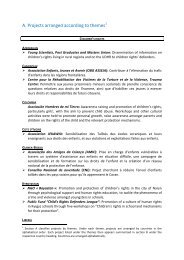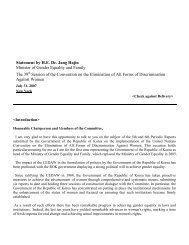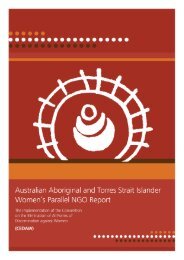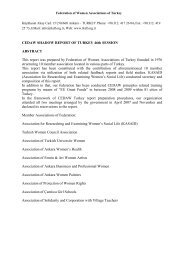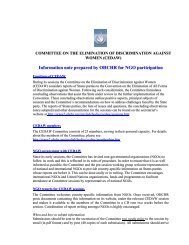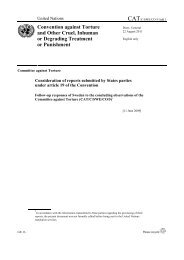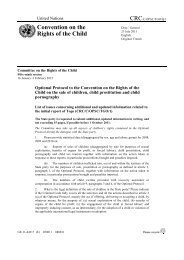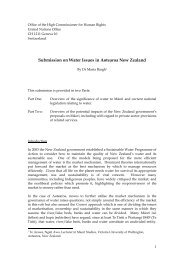Report - Office of the High Commissioner on Human Rights
Report - Office of the High Commissioner on Human Rights
Report - Office of the High Commissioner on Human Rights
- No tags were found...
You also want an ePaper? Increase the reach of your titles
YUMPU automatically turns print PDFs into web optimized ePapers that Google loves.
Participants used <str<strong>on</strong>g>the</str<strong>on</strong>g> tool kit methodology to develop testim<strong>on</strong>ies presented to <str<strong>on</strong>g>the</str<strong>on</strong>g> Special Rapporteur<br />
during <str<strong>on</strong>g>the</str<strong>on</strong>g> C<strong>on</strong>sultati<strong>on</strong>. (See Annex G for cases developed by participants using <str<strong>on</strong>g>the</str<strong>on</strong>g> Tool Kit<br />
methodology and Annex H for <str<strong>on</strong>g>the</str<strong>on</strong>g> testim<strong>on</strong>ies, in full)<br />
2.5 “Unpacking” and Applying <str<strong>on</strong>g>the</str<strong>on</strong>g> Tool Kit to <str<strong>on</strong>g>the</str<strong>on</strong>g> Right to Adequate Housing and Gender 12<br />
It is critical to situate <str<strong>on</strong>g>the</str<strong>on</strong>g> elements <str<strong>on</strong>g>of</str<strong>on</strong>g> <str<strong>on</strong>g>the</str<strong>on</strong>g> right to adequate housing and <str<strong>on</strong>g>the</str<strong>on</strong>g> tool kit methodology within<br />
<str<strong>on</strong>g>the</str<strong>on</strong>g> c<strong>on</strong>text <str<strong>on</strong>g>of</str<strong>on</strong>g> <str<strong>on</strong>g>the</str<strong>on</strong>g> Pacific regi<strong>on</strong>. It is important to understand how <str<strong>on</strong>g>the</str<strong>on</strong>g> forms <str<strong>on</strong>g>of</str<strong>on</strong>g> discriminati<strong>on</strong><br />
experienced by women in <str<strong>on</strong>g>the</str<strong>on</strong>g> Pacific are mapped in relati<strong>on</strong> to <str<strong>on</strong>g>the</str<strong>on</strong>g> elements, how <str<strong>on</strong>g>the</str<strong>on</strong>g> discriminati<strong>on</strong>s<br />
manifest <str<strong>on</strong>g>the</str<strong>on</strong>g>mselves, and what possible redress measures and remedies exist.<br />
2.5.1 N<strong>on</strong>-discriminati<strong>on</strong> and gender equality in <str<strong>on</strong>g>the</str<strong>on</strong>g> right to adequate housing<br />
N<strong>on</strong>-discriminati<strong>on</strong> and gender equality are two <str<strong>on</strong>g>of</str<strong>on</strong>g> <str<strong>on</strong>g>the</str<strong>on</strong>g> overriding principles that apply to all human<br />
rights, including <str<strong>on</strong>g>the</str<strong>on</strong>g> human right to adequate housing. Having a detailed understanding <str<strong>on</strong>g>of</str<strong>on</strong>g> <str<strong>on</strong>g>the</str<strong>on</strong>g>se<br />
principles and <str<strong>on</strong>g>the</str<strong>on</strong>g>ir relati<strong>on</strong>ship to <str<strong>on</strong>g>the</str<strong>on</strong>g> human right to adequate housing provides <str<strong>on</strong>g>the</str<strong>on</strong>g> tools to challenge<br />
<str<strong>on</strong>g>the</str<strong>on</strong>g> justificati<strong>on</strong>s <str<strong>on</strong>g>of</str<strong>on</strong>g>fered for <str<strong>on</strong>g>the</str<strong>on</strong>g> persistence <str<strong>on</strong>g>of</str<strong>on</strong>g> <str<strong>on</strong>g>of</str<strong>on</strong>g>ficial and social practices that serve to discriminate<br />
against women in land and housing.<br />
a. Gender differences: Comm<strong>on</strong> heritage <str<strong>on</strong>g>of</str<strong>on</strong>g> humans<br />
Some gender differences are biological while some are culturally c<strong>on</strong>structed. As culturally c<strong>on</strong>structed,<br />
gender differences tend to vary across cultures and time. This would also seem to imply that <str<strong>on</strong>g>the</str<strong>on</strong>g>y are<br />
dynamic and capable <str<strong>on</strong>g>of</str<strong>on</strong>g> evolving over time, and <str<strong>on</strong>g>the</str<strong>on</strong>g>refore have <str<strong>on</strong>g>the</str<strong>on</strong>g> potential <str<strong>on</strong>g>of</str<strong>on</strong>g> c<strong>on</strong>tributing to <str<strong>on</strong>g>the</str<strong>on</strong>g><br />
advancement women’s equality. Most noti<strong>on</strong>s <str<strong>on</strong>g>of</str<strong>on</strong>g> gender in our cultures help to perpetuate <str<strong>on</strong>g>the</str<strong>on</strong>g> myth<br />
that gender differences are ‘natural,’ and <str<strong>on</strong>g>the</str<strong>on</strong>g>refore cannot be changed. What is <str<strong>on</strong>g>the</str<strong>on</strong>g>refore needed is <str<strong>on</strong>g>the</str<strong>on</strong>g><br />
rigorous examinati<strong>on</strong> <str<strong>on</strong>g>of</str<strong>on</strong>g> <str<strong>on</strong>g>the</str<strong>on</strong>g> gendered ideologies that inform <str<strong>on</strong>g>the</str<strong>on</strong>g>se stereotyped and artificial noti<strong>on</strong>s<br />
<str<strong>on</strong>g>of</str<strong>on</strong>g> gender. The changing <str<strong>on</strong>g>of</str<strong>on</strong>g> gender ideology, <str<strong>on</strong>g>the</str<strong>on</strong>g>refore, lies at <str<strong>on</strong>g>the</str<strong>on</strong>g> heart <str<strong>on</strong>g>of</str<strong>on</strong>g> CEDAW, and serves as an<br />
overriding principle <str<strong>on</strong>g>of</str<strong>on</strong>g> gender equality.<br />
Gender differences per se are not a problem. The problem arises when such differences are used to<br />
justify discriminati<strong>on</strong>, and result in <str<strong>on</strong>g>the</str<strong>on</strong>g> unequal treatment <str<strong>on</strong>g>of</str<strong>on</strong>g> women (i.e. unequal power, unequal<br />
opportunities, unequal resources, unequal resp<strong>on</strong>sibilities and unequal rights). Gender differences have<br />
been historically used to justify discriminati<strong>on</strong> against women, resulting in gender inequality.<br />
b. Models <str<strong>on</strong>g>of</str<strong>on</strong>g> Equality: Comm<strong>on</strong> language <str<strong>on</strong>g>of</str<strong>on</strong>g> human rights<br />
In <str<strong>on</strong>g>the</str<strong>on</strong>g> history <str<strong>on</strong>g>of</str<strong>on</strong>g> women’s movements, different models <str<strong>on</strong>g>of</str<strong>on</strong>g> equality have been used, some being <str<strong>on</strong>g>of</str<strong>on</strong>g> greater<br />
service than o<str<strong>on</strong>g>the</str<strong>on</strong>g>rs.<br />
• Formal/Sameness model – characterized by women’s pursuit <str<strong>on</strong>g>of</str<strong>on</strong>g> <str<strong>on</strong>g>the</str<strong>on</strong>g> same rights as men (e.g. laws<br />
that appear as if <str<strong>on</strong>g>the</str<strong>on</strong>g>y are sex/gender neutral).<br />
The limitati<strong>on</strong> <str<strong>on</strong>g>of</str<strong>on</strong>g> this model is that it uses male standards, determined by men’s experiences, which<br />
ignore women’s different experiences and needs. Women are thus prevented from exercising <str<strong>on</strong>g>the</str<strong>on</strong>g>ir<br />
formal rights because to do so may expose <str<strong>on</strong>g>the</str<strong>on</strong>g>m to violence/hostility, prevent <str<strong>on</strong>g>the</str<strong>on</strong>g>m from accessing<br />
opportunities, or c<strong>on</strong>flict with <str<strong>on</strong>g>the</str<strong>on</strong>g>ir existing resp<strong>on</strong>sibilities. When, due to such reas<strong>on</strong>s, women<br />
12<br />
See Annex C for <str<strong>on</strong>g>the</str<strong>on</strong>g> full power point presentati<strong>on</strong> delivered by Dianne Otto.<br />
14 WOMEN’S RIGHTS TO ADEQUATE HOUSEING AND LAND




